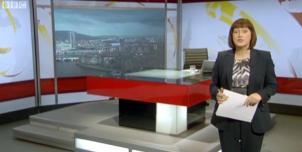Full Freeview on the Divis (Northern Ireland) transmitter
| Google Streetview | Google map | Bing map | Google Earth | 54.607,-6.009 or 54°36'24"N 6°0'34"W | BT17 0NG |
The symbol shows the location of the Divis (Northern Ireland) transmitter which serves 440,000 homes. The bright green areas shown where the signal from this transmitter is strong, dark green areas are poorer signals. Those parts shown in yellow may have interference on the same frequency from other masts.
This transmitter has no current reported problems
The BBC and Digital UK report there are no faults or engineering work on the Divis (Northern Ireland) transmitter._______
Digital television services are broadcast on a multiplexes (or Mux) where many stations occupy a single broadcast frequency, as shown below.
64QAM 8K 3/4 27.1Mb/s DVB-T MPEG2
DTG-12 QSPK 8K 3/4 8.0Mb/s DVB-T MPEG2
H/V: aerial position (horizontal or vertical)
Which Freeview channels does the Divis transmitter broadcast?
If you have any kind of Freeview fault, follow this Freeview reset procedure first.Digital television services are broadcast on a multiplexes (or Mux) where many stations occupy a single broadcast frequency, as shown below.
64QAM 8K 3/4 27.1Mb/s DVB-T MPEG2
DTG-12 QSPK 8K 3/4 8.0Mb/s DVB-T MPEG2
H/V: aerial position (horizontal or vertical)
Which BBC and ITV regional news can I watch from the Divis transmitter?

BBC Newsline 0.6m homes 2.5%
from Belfast BT2 8HQ, 1,044km northeast (51°)
to BBC Northern Ireland region - 46 masts.
Are there any self-help relays?
| Chapel Fields | Transposer | Central Belfast | 61 homes |
How will the Divis (Northern Ireland) transmission frequencies change over time?
| 1950s-80s | 1984-97 | 1997-98 | 1998-2012 | 2012-13 | 4 Mar 2020 | ||||
| VHF | A K T | A K T | A K T | K T | W T | ||||
| C1 | BBCtvwaves | ||||||||
| C21 | C4waves | C4waves | C4waves | +D3+4 | D3+4 | ||||
| C23 | SDN | SDN | |||||||
| C24 | ITVwaves | ITVwaves | ITVwaves | BBCB | BBCB | ||||
| C26 | ArqA | ArqA | |||||||
| C27 | BBC2waves | BBC2waves | BBC2waves | BBCA | BBCA | ||||
| C29 | ArqB | ||||||||
| C30 | LBT | ||||||||
| C31 | BBC1waves | BBC1waves | BBC1waves | ||||||
| C33 | com7 | ||||||||
| C34 | com8 | ||||||||
| C36 | _local | ||||||||
| C48 | NIMM | NIMM | |||||||
| C55tv_off | com7tv_off | ||||||||
| C56tv_off | COM8tv_off |
tv_off Being removed from Freeview (for 5G use) after November 2020 / June 2022 - more
Table shows multiplexes names see this article;
green background for transmission frequencies
Notes: + and - denote 166kHz offset; aerial group are shown as A B C/D E K W T
waves denotes analogue; digital switchover was 10 Oct 12 and 24 Oct 12.
How do the old analogue and currrent digital signal levels compare?
| Analogue 1-4 | 500kW | |
| BBCA, D3+4, BBCB | (-7dB) 100kW | |
| SDN, ARQA, ARQB | (-10dB) 50kW | |
| com8 | (-16dB) 12.7kW | |
| com7 | (-16.1dB) 12.4kW | |
| LBT | (-20dB) 5kW | |
| Mux 1*, Mux 2*, Mux A*, Mux B* | (-23.4dB) 2.3kW | |
| Mux C* | (-24dB) 2kW | |
| Mux D* | (-24.9dB) 1.6kW | |
| NIMM | (-47dB) 10W |
Which companies have run the Channel 3 services in the Divis transmitter area
|
|
Saturday, 14 September 2019
C
CP12:25 PM
Thanks so much Chris.SE. What is the plan for the channels that currently reside on com7/8 when they close down? I actually like some of them!
I haven't changed anything, but am now able to receive and tune com8 on Ch 60, albeit with pretty variable signal quality, but get nothing on com7 on Ch 51.
I used an SDR dongle as a very rudimentary spectrum analyser, and I am receiving an 8MHz wide signal that is centred around 714MHz, which corresponds to Ch 51. In terms of raw received power it is actually comparable to the other muxes, but as you suggest it must be getting scrambled with interference as all of my devices read 0 signal quality and are unable to tune it. I'm not sure that there is too much I can do about that.
| link to this comment |
Tuesday, 1 October 2019
Hi can anyone confirm Claremont Carn has reduced its power on 52 and 56? As there is no response the site.
| link to this comment |
C
Chris.SE3:22 PM
CARL READE:
Don't know if these sites are any help, Clermont Carn has supposedly changed channels to 42 & 45.
http://coverage.2rn.ie/in….php
Saorview
Information certainly seems sparse, I wonder if anyone else has any info/links etc.?
| link to this comment |
Chris.SE: Yea was on the site zero info. They are still at 52, 56 and 42, 45 but people telling me they have lost 52, 56. Strange as they didn't move after the retune.
| link to this comment |
Wednesday, 2 October 2019
C
Chris.SE3:58 PM
CARL READE:
It's possible they may be simulcasting for a while (possibly on lower power?) so that people with unsuitable aerials have time to get them changed. They've simulcasted PSB1/BBCA on a few transmitters in GB when main mux channels have moved from group C/D aerial to group A.
| link to this comment |
Sunday, 6 October 2019
CP re Ch51
I am in a 2nd floor flat in Killyleagh, not line of sight from Divis. Communal small-ish log-periodic in the loft. LG TV.
Ch51 shows sig strength of 70%, a bit variable but no pic drop outs or pixellation on any of the 10 TV channels (including BBC News HD and Smithsonian.
Ch60 is weaker at 50% but the picture is OK.
Ch33 is not shown on the main list, but has good signal strength. Carries only NvTv and a few Sony channels.
The Black Mountain RTE channels are listed at 2kW eirp, but it must have been upped a lot as I am now getting 100% signal strength, as with the PSB transmissions. Perhaps they have moved it to Divis?
| link to this comment |
Denis's: mapD's Freeview map terrainD's terrain plot wavesD's frequency data D's Freeview Detailed Coverage
Thursday, 10 October 2019
C
CP1:52 PM
Thanks for the detailed info Denis. I'm a couple of miles and line of sight from Divis, so I couldn't understand what was going on. In case it helps anyone else I have now solved my tuning problems. It turns out the problem was...my flyleads!
I have 3 flyleads in series - one from the antenna wall socket to a surge suppressor, from the suppressor to my PVR, then another from the PVR to the TV. The ones to / from the PVR came with it.
My problem was that at the TV I was getting a zero signal strength reading for Ch 51 (com7) while Ch 60 (com8) was intermittently reading either 0 signal strength or occasionally 30-40%, but very poor quality.
I mentioned before that using a basic spectrum analyser showed that I appeared to be getting decent signal peaks at the appropriate frequencies, so I didn't know what was going on. However, I was only testing this at the end of the flylead from the wall socket. Doh!
A few nights ago I noticed that when I accidentally touched and moved one of the flyleads to / from PVR I suddenly briefly received better reception on Ch 60. Wondering if they were faulty I then replaced both PVR flyleads with a couple of homemade ones I put together from WF100 cable I had lying around. After replacing one, Ch60 signal strength improved to around 60%, and after replacing the second I now have a signal strength of 80+% on Ch60 and 50+% on Ch51, both with 100% signal quality!
The old flyleads were typical of those you get with devices like PVRs. They weren't that thick, but didn't appear particularly cheap. Their connectors appeared alright too. I'm not sure if they had a really poor frequency response and were overly attenuating higher frequency channels, which became noticeable when the Com7 / 8 muxes moved up to Ch 51/60, or if they just have very poor shielding and were picking up lots of interference at those frequencies. In any case, replacing them with good quality, well shielded cabling has completely solved my problem and was relatively quick and easy to do. Worth considering if anyone else has similar problems.
Thanks to all those here who contributed advice / information.
| link to this comment |
C
Chris.SE5:55 PM
CP:
Glad you have solved your problem. From my experience with these "pre-fabricated" fly-leads, they can often develop a break on the centre core where they enter the back of the plug. I've never discovered whether it's just a poor method of connection or the wire physically breaking, I've just binned them!
| link to this comment |
Friday, 11 October 2019
CP
It happens! <lol> I've found flyleads with centre conductor just pushed into the pin, unsoldered. You can get ones with a grubscrew but I prefer to solder them - guess iI'm old fashioned! That's the Belling Lee type, you can't of course solder the F type, where the conductor is the pin.
What antenna do you use? I'm asking because a friend lives a couple of miles from Divis, and gets poor reception with a set-top aerial.
What SDR dongle do you use?
Denis GI3TAC
| link to this comment |
Denis's: mapD's Freeview map terrainD's terrain plot wavesD's frequency data D's Freeview Detailed Coverage
N
nobody10:33 PM
Denis: But, assuming we aren't powering something, do we need a DC connection at all, given that the stray capacitance between the centre conductor and pin is a virtual short at these frequencies?
| link to this comment |
Select more comments
Your comment please!







